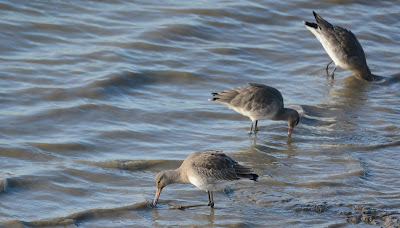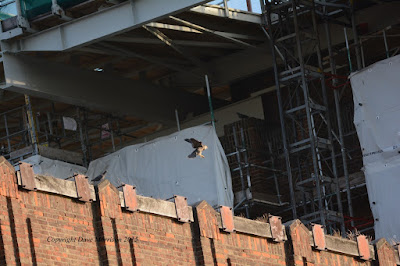November 26th
Every winter, courtesy of the Environment Agency, I undertake a high tide wader survey around the above date for annual consistency on the Inner Thames.
This is its 5th year running and it basically starts from Tilbury Docks, we then head up river to Beckton. The idea is to catch the highest tide at Tilbury and then check all roosts as we head up, it works quite well and provides some good yearly comparison data.
In truth this year I expected the counts to be way down due to the mild weather and the ever present westerly/south westerly strong winds. With little chance of a northerly/easterly/north easterly to help migrant waders clear the North Sea numbers would surely be affected.
On the morning of the survey we launched at Crossness, from here it was a dash down river to Tilbury Docks; we gave it a while here to let the tide fully cover all the mud.
 |
| Launching at Crossness |
As we started Broadness Point was covered and revealed a single Curlew, 30 Lapwing and 25 Redshank at roost. I also had a good look around here, in the past it has produced Turnstone, up to 7 birds one winter.
Pressing on we headed for the West Thurrock/Greenhithe area, only 6 Curlew at roost here on the West Thurrock side along with a single Oystercatcher.
Greenhithe fared better with 400 Dunlin and 100 Redshank as the main species, again both these sites have produced large numbers of these species in past winters.
 |
| Stone ness Point |
 |
| Add caption |
We also started to pick up various Warships, en route to the Isle of Dogs I suspect, or laying up alongside HMS Belfast, not sure what the occasion was but a spectacular sight.
Moving on after visiting roosts at Purfleet, Littlebrook and Erith we eventually arrived at the Stone Barges, this proved occupied with good numbers of Black Tailed Godwit and Redshank present roosting.
After scanning the birds for around 5-10 minutes I arrived at a count of 70 Redshank and 250 Black Tailed Godwits, the odd Dunlin and Lapwing mixed in amongst them.
The Barges have been there as long as I can remember, as a kid in the 60’s I can recall visiting them with my parents, I suspect they could well have been there since the 2nd World War. In these days of change and environmental pressures, nothing ever seems to stay the same; hopefully they will remain and continue to provide roosts for Waders.
From here we headed a short way upriver to Dagenham Riverside, this is a roost I watch a lot, it is a large old derelict jetty, in the past it has produced counts of 1500+waders.It is also a regular winter Curlew roost, other than Rainham Marshes RSPB and Stone Ness Saltings, this is the only other Inner Thames Curlew roost site that I know of.
It produced a respectable 10 birds, given the species status recently as now threatened and on the Red List, it is important that none of these winter roost sites are lost or come under threat. I must admit to thinking it is a wader I take for granted along the Inner Thames, sad news that it is declining.
Also on the Jetty were 7 Black Tailed Godwit, 20 Lapwing and 70 Redshank.
With the count recorded we headed upriver to the next roost at Beckton, checking Barking Bay roost en route showed an empty Jetty other than 40 odd Shelduck.
At Beckton 50 Redshank and a couple of Dunlin were present along the River Wall with a good number of Shelduck here also.
Our last port of call was Crossness River Wall; this is one of the big roosts in the Inner Thames and always provides good counts.
This is our jetty where we dock so it gave me plenty of time to scan the wall for numbers, it was obvious Dunlin were present in force, I eventually arrived at the following
Dunlin – 800
Black Tailed Godwit – 9
Redshank - 130
Lapwing – 60
A good survey overall, as expected numbers were down on the winter of 2014/2015, hopefully this is just a reflection on the mild weather. A lot of winter bird movement is cold weather related so likely many more will arrive when winter takes a hold.
Final Totals
Curlew – 17
Redshank – 500
Lapwing – 275
Dunlin – 1211
Oystercatcher – 1
Black Tailed Godwit – 266
Ringed Plover – 1





















































